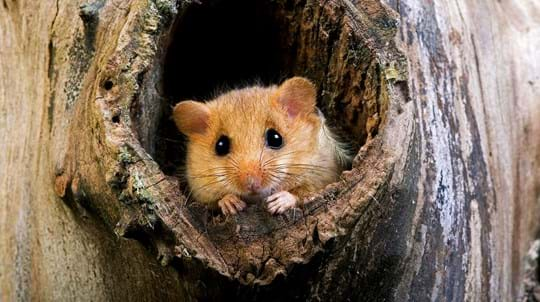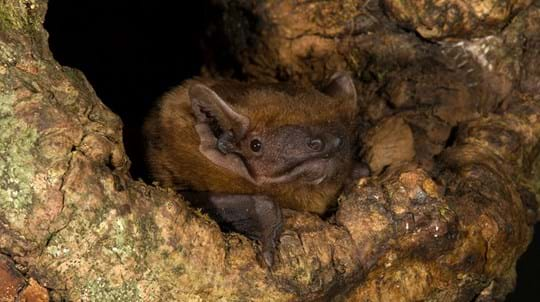
Credit: FLPA / Alamy Stock Photo
Hibernation
These bats hibernate during the wintertime. Small groups of them roost in crevices in caves, cellars and tunnels.
Small and shaggy, this pink-faced bat is often found in wet woodland. Keep your eyes peeled for them at dusk when they come out to hunt.
Common name: Brandt’s bat
Scientific name: Myotis brandtii
Family: Vespertilionidae
Habitat: woodland, farmland
Diet: moths, midges, spiders
Predators: birds of prey
Origin: native
One of the smaller bat species, Brandt’s bats measure around 4-5cm in length and weigh in at 4.5-9.5g. They have long, shaggy fur which is dark brown in colour, with a grey belly. They have a pink face, small nose and slim, pointed ears.
Not to be confused with: the whiskered bat. The two species were actually considered the same up until 1970 when they were separated. Brandt’s bats are very similar to the whiskered bat but are slightly larger in size.
The Brandt’s bat’s diet consists of moths, midges and spiders, which it catches on the wing when it heads out to hunt after sunset. They utilise their quick and skilful flight to take their prey, often picking it off foliage low to the ground, as well as foraging near water.
The Brandt's bat is famed for its longevity – it can live for up to 40 years!
The breeding season occurs during the autumn months, with females then forming maternity colonies ready to give birth the following summer. Usually, a single pup is born in June or July.

Credit: FLPA / Alamy Stock Photo
These bats hibernate during the wintertime. Small groups of them roost in crevices in caves, cellars and tunnels.
Brandt’s bats live in woodland, often in areas close to water. They are found throughout England and Wales but are absent from Northern Ireland and most of Scotland.
Keep an eye out for this bat in woodland, particularly wooded areas near water. Your best chance of a sighting is just after sunset.

Credit: Simon NL West / WTML
Little is known about the population status of this species, but they are protected under the Wildlife and Countryside Act 1981, as well as being a European protected species. The main threat to Brandt’s bat is habitat loss caused by a reduction in woodland and loss of prey due to increased pesticide use and changes to agricultural practices.

Trees woods and wildlife
Trees and woods provide a stable habitat and food supply for many mammals. What will you spot?

Trees woods and wildlife
Discover why woods and trees are important to the roosting, foraging and navigation needs of bats.

Blog
Joe Bates • 03 Dec 2018

Woodland wildlife is fading before our eyes. Please support our appeal to save rare and threatened species.
Donate now